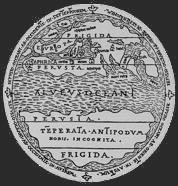 |

|
 View of the world by philosopher Ambrosius Macrobius (395-423 BC) on a map of 1483 (GEO Spezial, 01/2003)  "Tabulae Rudolphinae: quibus astronomicae ...." by Johannes Kepler, 1571—1630 (NOAA Central Library)  Roald Amundsen's expedition to the geographic South Pole (11/14/1911) (Photo: Roald Amundsen / Anne-Christine Jakobsen)  Robert Falcon Scotts expedition to the geographic South Pole (01/18/1912) (Photo: Lt. H.R. Bowers / Popperfoto, London) |
Introduction Even if one hasn't seen something with one's own eyes, this does not preclude that this "something" exists. This idea was already considered true in the ancient world. After the Greek philosopher and mathematician Pythagoras had established in the 6th century BC that the earth has the shape of a sphere, his compatriot Parmenides of Elea divided it into five parallel climate zones. Also the Greek philosopher Aristotle (384—322 BC) assumed that nature has a fundamental symmetry; thus his concept that the northern landmass under the Bear constellation (arktos) had to be balanced by a landmass on the opposite side (anti-arktos) of the sphere. The idea of Antarctica was born. Four hundred years later the Roman geographer Pomponius Mela picked up the idea of Antarctica as a counterbalancing continent in drawing a world map that shows a fictitious continent in the south. Later the Greek geographer and astronomer Ptolemaeus (87—150 AD) from Alexandria described in his eight-volume work "Explicatio geographica" the legendary Terra Australis Incognita as a landmass connecting Africa and India in the south. The unknown continent is portrayed as fertile and rich land separated from the rest of the world by a fire belt and terryfying monsters. Even if none of these scholars of Antiquity had ever seen this mysterious country, this didn't prevent them from claiming its existence. In the Middle Ages the idea of a "Sixth Continent" only slowly gained acceptance again. In 1520, when Magellan was circumnavigating South America, he wrongly mistook Tierra del Fuego for so far undiscovered Antarctica. This assumption was later rectified by Sir Francis Drake who found out that Magellan had only sighted an offshore island. It was only by chance that in 1599 the Dutchman Dirk Gerritsz became the first person to ever lay eyes on the legendary continent when spotting some offshore islands during one of his plundering expeditions to East India. But "consciously" (and with resolution) Antarctica was sighted for the first time in 1819 by the Russian academic Fabian Gottlieb von Bellingshausen. On January 26, 1820, he crossed the Arctic Circle. On January 1, 1821, he reached the southernmost point of his travel shortly before the 70 latitude. It was him who named the Peter I" Islandsland and the Alexander I Island". Returning to his czar on February 11, 1821, he had accomplished the first world circumnavigation on this high southern latitude. The first attempt to reach the South Pole was undertaken between 1901and1903 by an English expedition led by Sir Robert Falcon Scott, who had to give up at 82° southern latitude. Another English expedition (1907-1909), led by Sir Ernest Shackleton, failed on January 9, 1909, just around 180 km before their destination. The South Pole is reached on December 14, 1911, by the Norwegian Roald Amundsen. The second to reach the Pole was Scott on January 18, 1912, but he and his party died on their way back. Between 1914 and1916, Sir Ernest Shackleton set out on a new expedition, but his ship was trapped and crushed by the pack ice of the Antarctic Weddell Sea before he could even begin his "Imperial Trans Antarctic Expedition". He succeeded however to keep the whole crew during 20 months spent under the most adverse conditions of two Antarctic winters. The so far largest Antarctic expedition named "Operation High Jump" took place in 1946 under the leadership of Richard Byrd. It consisted of 13 ships, 23 airplanes and 4,700 soldiers and scientists of the US Navy. Thus most of the last unexplored territories of the planet were mapped. Subsequently 12 nations set-up approx. 40 research stations throughout numerous expeditions and settled selected places of Antarctica. The fantastic concepts of the ancient world of the southern continent changed into tangible political and material interests. Despite the fact that its image has become sharper and sharper, Antarctica still holds lots of secrets. So, among other things, the hope of science is to find indications for the future development of the earth's climate, whose past is conserved in an archive of an up to four kilometers thick layer of ice. Facts What has been found in Antarctica up to this date has confirmed the superlatives of fantasies about this continent. With an average temperature of between -50°C and -60°C, Antarctica is the coldest place on our planet, approx. 30°C colder than the North Pole. In July 1983 the Russian station Vostok measured a historic minimum of -89,6°C. Also. the Antarctic continent is the stormiest place on earth with a wind velocity up to 300 km/ph. More than 99% of the Antarctic surface, approximately one and a half times the size of Europe, is ice-covered. The average thickness of its ice shield is 2,500m, with a maximum of 4,776m. This corresponds equals three quarters of the world-wide fresh water supply; when melted, this amount of ice would rise the sea level around 60m. However, Antarctica is also one of the areas with the lowest precipitation rate. These extreme conditions explain a settlement merely comprising a community of scientists living in around 34 continuously manned research stations. Despite of the adverse climate, Antarctica is recognized as the last large intact ecosystem. The Antarctic continent is more than 1,000 km away from the southern tip of South America, and 2,500-3,000 km distant from New Zealand and Australia; Africa is only just 4,000 km away. "Imagine a country as large as Australia and Europe together, sunnier than California but colder than the icebox of a refrigerator, dryer than Arabia and higher than hilly Switzerland, emptier than the Sahara. There is only one place in the world that fits this description: Antarctica—this strange but beautiful continent in the lowest part of the Earth." (J. M. Dukert)  top top |